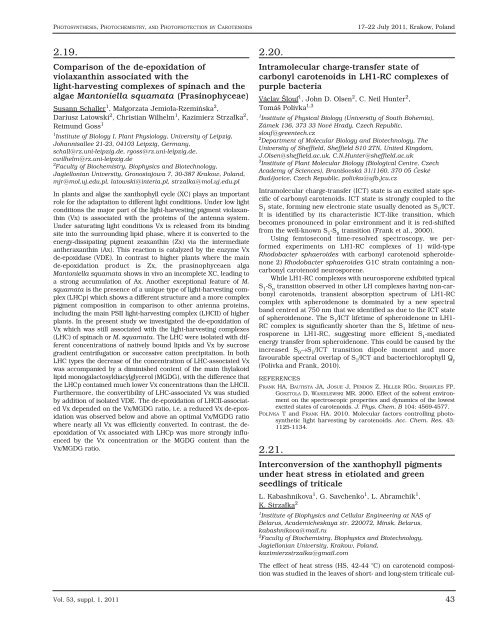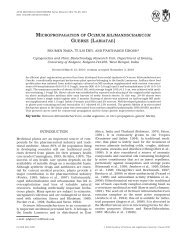ACTA BIOLOGICA CRACOVIENSIA
ACTA BIOLOGICA CRACOVIENSIA
ACTA BIOLOGICA CRACOVIENSIA
Create successful ePaper yourself
Turn your PDF publications into a flip-book with our unique Google optimized e-Paper software.
PHOTOSYNTHESIS, PHOTOCHEMISTRY, AND PHOTOPROTECTION BY CAROTENOIDS<br />
2.19.<br />
Comparison of the de-epoxidation of<br />
violaxanthin associated with the<br />
light-harvesting complexes of spinach and the<br />
algae Mantoniella squamata (Prasinophyceae)<br />
Susann Schaller1 , Małgorzata Jemioła-Rzemińska2 ,<br />
Dariusz Latowski2 , Christian Wilhelm1 , Kazimierz Strzałka2 ,<br />
Reimund Goss1 1Institute of Biology I, Plant Physiology, University of Leipzig,<br />
Johannisallee 21-23, 04103 Leipzig, Germany,<br />
schall@rz.uni-leipzig.de, rgoss@rz.uni-leipzig.de,<br />
cwilhelm@rz.uni-leipzig.de<br />
2Faculty of Biochemistry, Biophysics and Biotechnology,<br />
Jagiellonian University, Gronostajowa 7, 30-387 Krakow, Poland,<br />
mjr@mol.uj.edu.pl, latowski@interia.pl, strzalka@mol.uj.edu.pl<br />
In plants and algae the xanthophyll cycle (XC) plays an important<br />
role for the adaptation to different light conditions. Under low light<br />
conditions the major part of the light-harvesting pigment violaxanthin<br />
(Vx) is associated with the proteins of the antenna system.<br />
Under saturating light conditions Vx is released from its binding<br />
site into the surrounding lipid phase, where it is converted to the<br />
energy-dissipating pigment zeaxanthin (Zx) via the intermediate<br />
antheraxanthin (Ax). This reaction is catalyzed by the enzyme Vx<br />
de-epoxidase (VDE). In contrast to higher plants where the main<br />
de-epoxidation product is Zx, the prasinophyceaen alga<br />
Mantoniella squamata shows in vivo an incomplete XC, leading to<br />
a strong accumulation of Ax. Another exceptional feature of M.<br />
squamata is the presence of a unique type of light-harvesting complex<br />
(LHCp) which shows a different structure and a more complex<br />
pigment composition in comparison to other antenna proteins,<br />
including the main PSII light-harvesting complex (LHCII) of higher<br />
plants. In the present study we investigated the de-epoxidation of<br />
Vx which was still associated with the light-harvesting complexes<br />
(LHC) of spinach or M. squamata. The LHC were isolated with different<br />
concentrations of natively bound lipids and Vx by sucrose<br />
gradient centrifugation or successive cation precipitation. In both<br />
LHC types the decrease of the concentration of LHC-associated Vx<br />
was accompanied by a diminished content of the main thylakoid<br />
lipid monogalactosyldiacylglycerol (MGDG), with the difference that<br />
the LHCp contained much lower Vx concentrations than the LHCII.<br />
Furthermore, the convertibility of LHC-associated Vx was studied<br />
by addition of isolated VDE. The de-epoxidation of LHCII-associated<br />
Vx depended on the Vx/MGDG ratio, i.e. a reduced Vx de-epoxidation<br />
was observed below and above an optimal Vx/MGDG ratio<br />
where nearly all Vx was efficiently converted. In contrast, the deepoxidation<br />
of Vx associated with LHCp was more strongly influenced<br />
by the Vx concentration or the MGDG content than the<br />
Vx/MGDG ratio.<br />
Vol. 53, suppl. 1, 2011<br />
17–22 July 2011, Krakow, Poland<br />
2.20.<br />
Intramolecular charge-transfer state of<br />
carbonyl carotenoids in LH1-RC complexes of<br />
purple bacteria<br />
Václav Šlouf1 , John D. Olsen2 , C. Neil Hunter2 ,<br />
Tomáš Polívka1,3 1Institute of Physical Biology (University of South Bohemia),<br />
Zámek 136, 373 33 Nové Hrady, Czech Republic,<br />
slouf@greentech.cz<br />
2Department of Molecular Biology and Biotechnology, The<br />
University of Sheffield, Sheffield S10 2TN, United Kingdom,<br />
J.Olsen@sheffield.ac.uk, C.N.Hunter@sheffield.ac.uk<br />
3Institute of Plant Molecular Biology (Biological Centre, Czech<br />
Academy of Sciences), Branišovská 31/1160, 370 05 Èeské<br />
Budìjovice, Czech Republic, polivka@ufb.jcu.cz<br />
Intramolecular charge-transfer (ICT) state is an excited state specific<br />
of carbonyl carotenoids. ICT state is strongly coupled to the<br />
S 1 state, forming new electronic state usually denoted as S 1 /ICT.<br />
It is identified by its characteristic ICT-like transition, which<br />
becomes pronounced in polar environment and it is red-shifted<br />
from the well-known S 1 -S n transition (Frank et al., 2000).<br />
Using femtosecond time-resolved spectroscopy, we performed<br />
experiments on LH1-RC complexes of 1) wild-type<br />
Rhodobacter sphaeroides with carbonyl carotenoid spheroidenone<br />
2) Rhodobacter sphaeroides G1C strain containing a noncarbonyl<br />
carotenoid neurosporene.<br />
While LH1-RC complexes with neurosporene exhibited typical<br />
S 1 -S n transition observed in other LH complexes having non-carbonyl<br />
carotenoids, transient absorption spectrum of LH1-RC<br />
complex with spheroidenone is dominated by a new spectral<br />
band centred at 750 nm that we identified as due to the ICT state<br />
of spheroidenone. The S 1 /ICT lifetime of spheroidenone in LH1-<br />
RC complex is significantly shorter than the S 1 lifetime of neurosporene<br />
in LH1-RC, suggesting more efficient S 1 -mediated<br />
energy transfer from spheroidenone. This could be caused by the<br />
increased S 0 →S 1 /ICT transition dipole moment and more<br />
favourable spectral overlap of S 1 /ICT and bacteriochlorophyll Q y<br />
(Polívka and Frank, 2010).<br />
REFERENCES<br />
FRANK HA, BAUTISTA JA, JOSUE J, PENDON Z, HILLER RGG, SHARPLES FP,<br />
GOSZTOLA D, WASIELEWSKI MR. 2000. Effect of the solvent environment<br />
on the spectroscopic properties and dynamics of the lowest<br />
excited states of carotenoids. J. Phys. Chem. B 104: 4569-4577.<br />
POLÍVKA T and FRANK HA. 2010. Molecular factors controlling photosynthetic<br />
light harvesting by carotenoids. Acc. Chem. Res. 43:<br />
1125-1134.<br />
2.21.<br />
Interconversion of the xanthophyll pigments<br />
under heat stress in etiolated and green<br />
seedlings of triticale<br />
L. Kabashnikova1 , G. Savchenko1 , L. Abramchik1 ,<br />
K. Strzałka2 1Institute of Biophysics and Cellular Engineering at NAS of<br />
Belarus, Academicheskaya str. 220072, Minsk, Belarus,<br />
kabashnikova@mail.ru<br />
2Faculty of Biochemistry, Biophysics and Biotechnology,<br />
Jagiellonian University, Krakow, Poland,<br />
kazimierzstrzalka@gmail.com<br />
The effect of heat stress (HS, 42-44 °C) on carotenoid composition<br />
was studied in the leaves of short- and long-stem triticale cul-<br />
43












